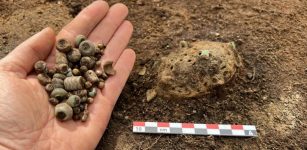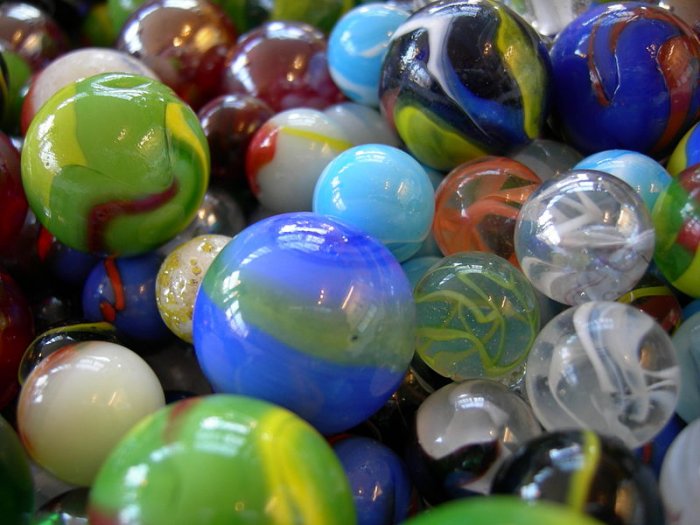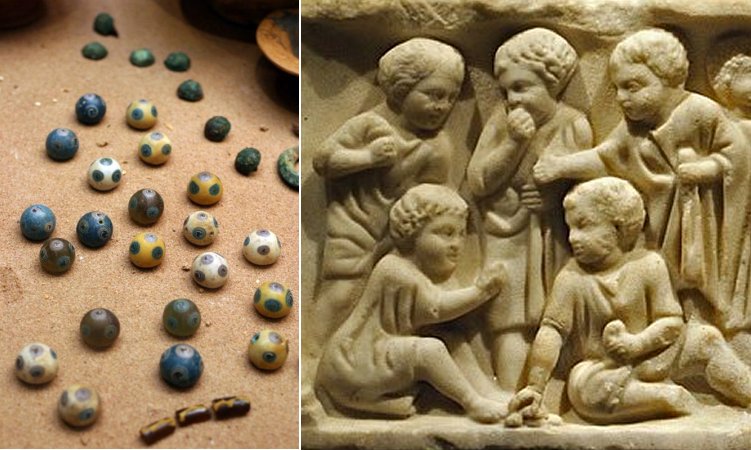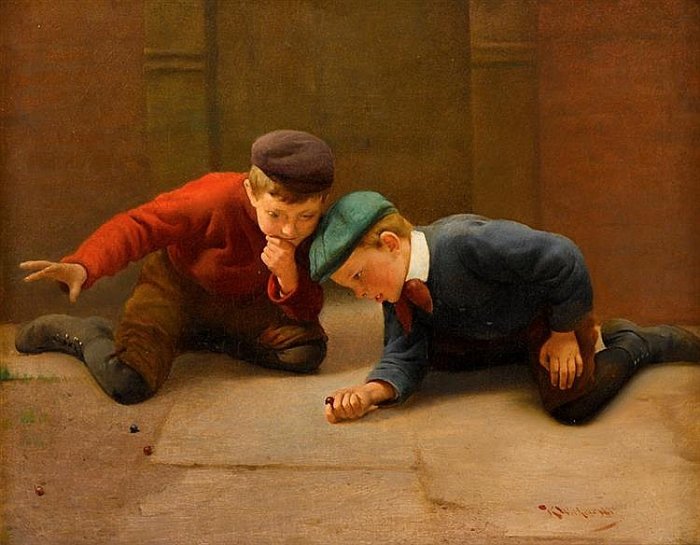Ancient Children Played Marbles Thousands Of Years Ago
Conny Waters - AncientPages.com - Kids will be kids, no matter what country, place or time. Some things are ageless and never go out of fashion.
Many modern children play with computer games, but some of the simplest toys are still as popular as they were thousands of years ago. It seems today’s children enjoy the same things as ancient kids did.
Marbles. Credit: Joe Mabel. CC BY-SA 3.0
Marble is a small spherical toy often made from glass, clay, steel, plastic. These balls are of different size and type. It’s fair to say it’s one of the simplest toys ever produced, but historical records show playing marbles can be fun.
It is unknown where marbles were first manufactured, but there is archaeological evidence that many games played today were enjoyed by children thousands of years ago. The first original marbles, the ones we are today familiar with were produced by a German glassblower in 1846.
Scientists have discovered small, colorful balls in pyramid tombs, and it seems marbles were part of the daily play of Egyptian children a long time ago. The oldest marble set was unearthed buried with an Egyptian child around 3,000 B.C. in a gravesite at Nagada.
Marbles made of clay have been discovered in prehistoric pueblo ruins in the southwestern United States, and in ancient Mexican ruins. Historians think the Aztecs enjoyed playing with marbles.
See also:
Ancient Egyptian Toys And Games In Focus
World’s Oldest Toy Car – Could This 7500-Year-Old Discovery Be The Earliest Evidence Of The Wheel?
What Was Life Like For Children In Ancient Athens?
It is thought that the Aztecs played a form of marbles. Clay marbles have been found in prehistoric pueblo ruins in the southwestern United States, in the classic periods Valley of Mexico ruins, and in the northern plains.
Small, ancient stone balls, identified by archaeologists as marbles have been unearthed near Mohenjo Daro, India and similar artifact have been discovered at prehistoric sites associated with Chaldeans of Mesopotamia.
In ancient Greece and Rome, children loved to play marbles. “On the Greek island of Crete, Minoan youths played with highly polished marbles of jasper and agate as early as 1435 B.C. And it is the Greeks, from their term for a polished white agate, marmaros, who gave us the word “marble.”
Left: Roman marbles. Credit: grandvoyageitaly.com - Right: Ancient Roman children. Credit: Public Domain
Marbles was a popular game among Roman children. The first Roman emperor, Caesar Augustus, would descend from his litter in order to join street children shooting marble pebbles and galls. Even clear glass marbles, fused from silica and ash, were manufactured in ancient Rome.
Despite the numerous marble artifacts obtained from ruins and the many references to the sport in extant texts, rules on how the game was played do not exist.” (Panati, Charles. Extraordinary Origins of Everyday Things)
Game of Marbles, Karol D. Witkowski. Credit: Public Domain
Celtic, Saxon and African children did not have such beautiful glass balls, but they used nuts and olives to play marbles.
We can add that marbles are mentioned in ancient literature and depicted on historical paintings.
It’s fascinating to see how this game developed independently in virtually every ancient culture, and it’s still popular in modern times.
Written by Conny Waters – AncientPages.com Staff Writer
Copyright © AncientPages.com All rights reserved. This material may not be published, broadcast, rewritten or redistributed in whole or part without the express written permission of AncientPages.com
More From Ancient Pages
-
 On This Day In History: 150 Highly-Trained Swiss Guards Entered Vatican For The First Time – On Jan 22, 1506
News | Jan 22, 2017
On This Day In History: 150 Highly-Trained Swiss Guards Entered Vatican For The First Time – On Jan 22, 1506
News | Jan 22, 2017 -
 Beautiful Neolithic Ornate Necklace With Over 2,500 Stones Found In A Child’s Grave
Archaeology | Aug 2, 2023
Beautiful Neolithic Ornate Necklace With Over 2,500 Stones Found In A Child’s Grave
Archaeology | Aug 2, 2023 -
 Nastrond (Náströnd): Grisly Hall Of Corpses – Norse Vision Of Most Terrible Place In Niflheim, Kingdom Of The Dead
Featured Stories | Sep 13, 2019
Nastrond (Náströnd): Grisly Hall Of Corpses – Norse Vision Of Most Terrible Place In Niflheim, Kingdom Of The Dead
Featured Stories | Sep 13, 2019 -
 Circular-Shaped 4000-Year-Old Wooden Henge Discovered In Yorkshire, Historic County of Northern England
Archaeology | Jan 3, 2018
Circular-Shaped 4000-Year-Old Wooden Henge Discovered In Yorkshire, Historic County of Northern England
Archaeology | Jan 3, 2018 -
 Pythagorean Cup Was A Practical Joke To Punish Greedy Drinkers And It Still Fools People
Ancient History Facts | Dec 18, 2020
Pythagorean Cup Was A Practical Joke To Punish Greedy Drinkers And It Still Fools People
Ancient History Facts | Dec 18, 2020 -
 Amazing Artifacts Found In Viking Double Grave In Norwegian Garden
Archaeology | Jul 10, 2023
Amazing Artifacts Found In Viking Double Grave In Norwegian Garden
Archaeology | Jul 10, 2023 -
 Unexplained Phenomena In Arkansas – Old Mysteries Still Puzzling The Modern World
Featured Stories | Jan 9, 2019
Unexplained Phenomena In Arkansas – Old Mysteries Still Puzzling The Modern World
Featured Stories | Jan 9, 2019 -
 Two-Story Houses With Balconies Unearthed In Ancient City Of Pompeii, Italy
Archaeology | May 18, 2018
Two-Story Houses With Balconies Unearthed In Ancient City Of Pompeii, Italy
Archaeology | May 18, 2018 -
 Hyksos: Foreign Rulers Of Avaris Who Founded The Fifteenth Dynasty Of Egypt
Civilizations | May 11, 2017
Hyksos: Foreign Rulers Of Avaris Who Founded The Fifteenth Dynasty Of Egypt
Civilizations | May 11, 2017 -
 Mysterious Bronze Age Viksö Helmets With Horns Related To Myths, Holy Animals And Divine Power
Artifacts | Feb 27, 2018
Mysterious Bronze Age Viksö Helmets With Horns Related To Myths, Holy Animals And Divine Power
Artifacts | Feb 27, 2018 -
 Stunning Discovery Of 1,000-Year-Old Knight’s Sword From Reign Of Poland’s First King Bolesław The Brave
Archaeology | Jul 28, 2022
Stunning Discovery Of 1,000-Year-Old Knight’s Sword From Reign Of Poland’s First King Bolesław The Brave
Archaeology | Jul 28, 2022 -
 Strange Case Of The Italian Doppelganger – A Tragedy – Part 1
Featured Stories | Oct 14, 2019
Strange Case Of The Italian Doppelganger – A Tragedy – Part 1
Featured Stories | Oct 14, 2019 -
 Ancient DNA Reveals Bronze Age Women Altered Genetic Landscape Of Orkney
Archaeology | Feb 7, 2022
Ancient DNA Reveals Bronze Age Women Altered Genetic Landscape Of Orkney
Archaeology | Feb 7, 2022 -
 Hades – Land Of The Dead In Greek Beliefs Offered Punishment And Paradise Full Of Harmony
Featured Stories | Aug 15, 2019
Hades – Land Of The Dead In Greek Beliefs Offered Punishment And Paradise Full Of Harmony
Featured Stories | Aug 15, 2019 -
 On This Day In History: Battle of Oosterweel Was Fought – On Mar 13, 1567
News | Mar 13, 2017
On This Day In History: Battle of Oosterweel Was Fought – On Mar 13, 1567
News | Mar 13, 2017 -
 Geomagnetic Fields Reveal The Truth Behind Biblical Narratives
Archaeology | Oct 25, 2022
Geomagnetic Fields Reveal The Truth Behind Biblical Narratives
Archaeology | Oct 25, 2022 -
 Mysterious 2,800-Year-Old Channel Installation Discovered In The City Of David, Jerusalem
Archaeology | Aug 30, 2023
Mysterious 2,800-Year-Old Channel Installation Discovered In The City Of David, Jerusalem
Archaeology | Aug 30, 2023 -
 New Attempt To Solve The Easter Island Mystery – What Did Rapa Nui Look Like Before Europeans Arrived?
Archaeology | Sep 20, 2017
New Attempt To Solve The Easter Island Mystery – What Did Rapa Nui Look Like Before Europeans Arrived?
Archaeology | Sep 20, 2017 -
 Deception And Hidden Truth – Ancient Struggle Of The Eagle And Serpent – Part 3
Ancient Mysteries | Sep 9, 2019
Deception And Hidden Truth – Ancient Struggle Of The Eagle And Serpent – Part 3
Ancient Mysteries | Sep 9, 2019 -
 All 5 Genetic ‘Letters’ Of DNA May Have Been Brought By Meteorites To Ancient Earth
DNA | May 21, 2022
All 5 Genetic ‘Letters’ Of DNA May Have Been Brought By Meteorites To Ancient Earth
DNA | May 21, 2022



